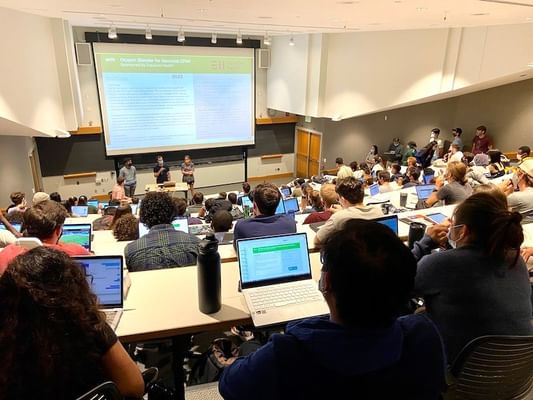- Undergraduate
Bachelor's Degrees
Bachelor of ArtsBachelor of EngineeringDual-Degree ProgramUndergraduate AdmissionsUndergraduate Experience
- Graduate
Graduate Experience
- Research
- Entrepreneurship
- Community
- About
-
Search
All Thayer News

BE Students Find Their Match after CEDC Lightning Round
Sep 30, 2021 | by Catha Mayor Lamm
Last week, Bachelor of Engineering (BE) students taking the two-term capstone design sequence (ENGS 89/90) attended the "Lightning Round"— the culmination of the Cook Engineering Design Center's (CEDC) annual industry project search. Student teams were randomly assigned to projects submitted to CEDC by companies or individuals in need of engineering solutions. The students researched their assigned project and provided a summary to their classmates along with a list of core knowledge areas needed and some background about the industry sponsor.

The Lightning Round: Forty-eight two-minute presentations were given by and to all 120 students completing the BE this year.
In all, 48 possible industry projects were presented, with a maximum of two minutes each, by and to all 120 students completing the BE program this year.
"CEDC Fellow Emma Doherty '21 worked all spring and summer to source and vet the 48 awesome projects that went into this Lightning Round," says Professor and CEDC Director Sol Diamond.
After hearing all the presentations, students ranked their top three project choices and then Professor Diamond entered each student's preferences, experience, and background into a script programmed to optimally match diverse teams of 4–6 students to a project. After running for approximately 60 hours, the script assigned teams to 24 of the 48 submitted projects with 70% of students matched with their first choice.
"I can also say, from the sponsor perspective, that one-hundred percent of teams meet the headcount and disciplinary coursework depth and relevant experience metrics that were determined in advance in order for projects to have qualified and capable student teams," says Diamond. This is no small feat given that 87.5% of the selected projects required course preparation in more than one discipline.
What's more, Diamond reported that 92% of teams have diverse representation along one or more of the surveyed axes of gender, race, and ethnic identity which bodes well for optimal creativity.
With the matching process complete, the students then collaborate with their industry sponsor to solve the problem. The entire capstone sequence, covering two 10-week terms, involves all the elements of the design process including feasibility studies, decision making, economic analysis, prototyping, and often final implementation.
Adds Diamond, "The Lightning Round presentations mean students get to see problems that otherwise might not even occur to them. They're learning: what do engineers do? That's what this course is all about. ... I wrote the script to try and take the guesswork out of making teams and end up with good matches with high diversity. Other universities are shifting to outside firms to find projects but we have our own way that leverages our alumni network, reputation, and a months-long vetting process that ensures projects call for a focus on human-centered engineering. That's what Dartmouth engineers do—solve human-centered engineering problems."
For contacts and other media information visit our Media Resources page.
